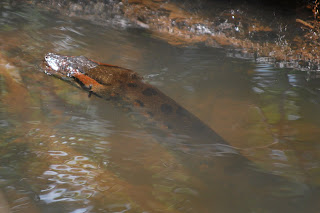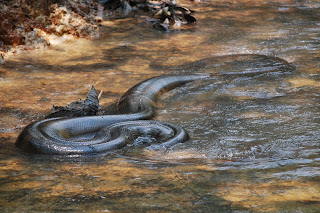We survived our first South American overnight bus - it was actually quite pleasant. The chairs reclined, but our knees were painfully sore from the lack of leg room. We arrived in Lago Agrios in the pouring rain at 6:30 in the morning. The city exists mainly for the oil and gas industry. From there it was a lot of "hurry up and wait". We took a bus from Lago Agrios a few hours down a windy road to "the bridge" and from there a motorized river canoe that seated 10 somewhat comfortably for another few hours. We saw lots of wildlife on the way to the lodge; monkeys and birds mostly.
 |
| Neiser, our extremely knowledgeable guide |
 |
| A spider monkey jumping between branches across the Cuyabeno river |
 |
.jpg) |
| Stinky Turkey birds (as our guide called them) were everywhere along the river banks. |
We arrived at Samona Lodge, in the Cuyabeno Nature Reserve around dinner time, "Checked into" our huts, and got our mosquito nets ready. After dinner we went for a night trek in the jungle - not for the arachnophobic! We saw tarantulas, spiders which fish (and eat their catch), colourful spiders, big spiders, little spiders, poisonous spiders... and some other bugs (and fish). Jimmy, a local 9-year old, came with us and caught a fish with a knife... in the dark. We swung on "tarzan ropes" hanging from the canopy.
 |
| A spider with it´s catch. It injects enxymes into it´s catch to digest it prior to eating. |
Day 2.
When we woke up it was sunny, but minutes before we embarked on our jungle trek, it began to pour... amazon style. We tried to wait it out, but our guide figured it probably wasn't going to stop, so we donned our panchos and set out anyways. It was a wet morning! Unfortunately, pictures are limited because the Nikon remained safely sealed in it's waterproof bag for most of the day.
Highlight of the day? Definitely not when had to jump a log which contained a very angered bee hive. We were the last two to cross, but came out relatively unscathed. Most other members of our group got at least a few bites. Our guide wasn't worried... apparently they weren't poisonous bees! (Whatever that means) Why didn't we go around the log, you ask? Because it was amazon bush-wacking.. and was therefore impossible.
Back at the lodge we found a sweet beetle, then got ready for a Pirhanna-fishing/ Caiman-finding trip.
.jpg)
How to catch a Pirhanna:
1. Find a stick... any will do.
2. Attach a short length of fishing line and a rusty hook.
3. Use some questionable meat as Pirhanna bait.
4. Lean over the edge of your canoe, and using the end of your stick, thrash wildly in the water, immitating a struggling animal which has fallen into the water.
5. Wait [patiently, or not] for a bite, but don't wait too long because the smaller fish will just pick away at your bait, until it's gone.
6. If you catch a pirhanna, remain calm and pull it out of the water.
7. Find someone braver (stupider?) to pull the hook out of the Pirhanna's mouth.
8. Take way too many photos, of various poses, then release the Pirhanna.
9. Repeat, as desired.
After the Pirhanna fun, we casually waited until it was dark enough (around 6:30pm here) to spot Caimans (river alligators) with our flashlights. We saw many, and got WAY TO CLOSE to a few. Apparently, Caimans assume you don't see them, even when the canoe is literally right over top of their 4-meter long bodies. It was terrifying, and thrilling at the same time. Here is the head of a "mama Caiman" as our guide called it.
Day 3.
Today we went further downstream to visit a local indigenous community. The neatest part of the day was making Yucca tortillas from scratch. Literally, we went into the jungle, harvested the roots, grated them, drained them, made it into a powder, and cooked the fine meal on a stone over an open fire until toasty. We are told that raw Yucca is very toxic, but very nutritious when cooked. The local kids were curious and adorable.
We saw a lot of wildlife along the river on the way to and from the community. Here are some happy turtles. After dusk, we did some more fishing, snake-searching, caiman-spotting, and even happened upon a rare owl (whose name we forget at the moment).

Day 4.
Today we witnessed, first hand (maybe participated a little) a standoff between a 7meter long (and 30cm thick) Anaconda and a 1.5meter electric eel. It was definitely the highlight of our trip so far... if not one of the coolest things either of us have ever done. Our guide took us (and two of our friends; Josh & King) out in the canoe into the depths of one the Amazon tributaries. From there we hiked by foot looking for signs of an Anaconda. We began to find pieces of freshly shed skin and followed the trail.
It wasn't long before our guide found the snake in the bottom of the creek... shortly after we discovered the electric eel. The two were fighting, and the whole situation was just unreal. Even our guide, who sees these things pretty regularly was as excited as we were. We were chasing the Anaconda up the creek, and our guide, Naiser, grabbed it by the tail. Both of us got to grab the tail of the anaconda as well; something we aren't sure would have happened without the adrenaline rush that accompanied the whole situation.
On the way back we went for a quick dip in the river in our muddy clothes to refresh ourselves from the scorching hot adrenaline-pumped day! The rest of the day was spent lounging, napping, rehydrating, and recapping the days events in hammocks in a hut at our lodge. Oh, and Lisa got brave enough to pick up a tarantula. They are actually quite chill! (Alex dissagrees with this statement)
Day 5.
Today we did the reverse day-long trip as on day one, and saw more wildlife still. All in all, it was an incredible adventure. We took a night bus from Lago Agrio to Baños, where we are now (details to come in a later post), which was nowhere near as enjoyable as the first night bus. There were military checkstops on the road, apparently for purposes of minimizing drug smuggling from the Colombian border. The TV (right in front of us on the bus) blaired terrible, loud, Spanish stand-up comedy until early in the morning. Not long after this quit (around 4am) the bus started stopping to pick up people every 5 minutes. But we are safe and sound (and happy) now. Adios for now!
.jpg)

.jpg)
.jpg)






.jpg)






.jpg)







Hi Alexandra and Lisa - love your blog - the text is informative and entertaining and the pics are great ( I might be slightly biased) I love Alex's expressions with the beetle and especially the one with the piranha! (just makes me laugh every time I look at it) Your Amazon adventure was like watching Kratz Creatures.
ReplyDeleteHey Lisa, Catherine's been keeping me posted on your blog, pretty cool stuff, but she had to get me to close the computer for her after seeing your amazon pics. haha, Big spiders and snakes are not really her thing. Hope you guys are having fun!
ReplyDelete-NEAL
Woah Alex, sounds like you are having a wicked time!! See, I always told you South America is fantastic! I love the pictures- they look MUCH more professional than mine ever were. I'll be in Brazil by the middle of October. Will you still be travelling then? When in Bolivia, make sure to visit Potosi. Interesting place, though the mines are clausterphobic-inducing. Chew some coca leaves for me!
ReplyDeleteMaris
Hey you two! Glad to see that all is going well and everything is so exciting. We were hiking around Cinque Terre, Italy yesterday in the pouring rain and it's amazing how much this place looks like the Andes in Peru (especially in the rain). The Incas must have been in Italy and started all the terrace farming here on the Ligurian Sea. Hey Lisa, I used to catch Tarantulas when I was a kid which really creeped my mother out! Off to France tomorrow for a week of cycling. Take care! Liz
ReplyDeleteThank you a lot for providing individuals with a very spectacular possibility to read critical reviews from this site.
ReplyDelete---------------------
Best Zipline Maui
red bottom shoes
ReplyDeleteceline outlet
chanel outlet
michael kors outlet
cheap toms shoes
adidas originals
polo ralph lauren
oakley sunglasses wholesale
ray ban sunglasses
coach factory outlet
chenlina20161223
Beautiful Amazonia and its forests, vital oxygen for Earth
ReplyDelete